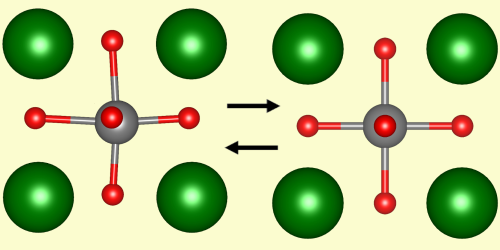Light Could Drive Cooling Cycle in Ferroelectric Materials
Claudio Cazorla of the Polytechnic University of Catalonia in Spain and his collaborators have used a suite of numerical methods to discover that the archetypal ferroelectric material, potassium niobate (KNO), also exhibits a photocaloric effect: In response to ultraviolet light, KNO reversibly absorbs heat [1]. Because the effect is large and works at a wide range of temperatures, including room temperature, KNO could serve as the working medium for new cooling devices.
KNO owes its ferroelectric and photocaloric effects to its perovskite crystal structure, which features a niobium ion surrounded by an octahedral cage of oxygen ions. At low temperatures, the niobium ion is offset from the cage’s center, which induces an electric polarization (the ferroelectric effect). Above 700 K, KNO adopts a nonpolar configuration as its most stable phase.
Cazorla and his collaborators realized that the nonpolar phase is also the most stable at lower temperatures if KNO is illuminated with UV photons able to promote electrons to the conduction band. Expose KNO to such light, and it should absorb heat from a low-temperature environment (the amount of heat is related to the thermal energy of the high-temperature phase). Turn off the light, and KNO should relax to its polar state and shed the heat.
For caloric materials, a figure of merit is the isothermal entropy change S, which measures how much heat can be extracted at a given temperature. Cazorla and his collaborators calculated that KNO’s S is 100 J K−1 kg−1, comparable to other materials being considered for solid-state refrigeration. A possible advantage for KNO is that its photocaloric effect is estimated to persist over a useful range of 200–400 K.
–Charles Day
Charles Day is a Senior Editor for Physics Magazine.
References
- R. Rurali et al., “Giant photocaloric effects across a vast temperature range in ferroelectric perovskites,” Phys. Rev. Lett. 133, 116401 (2024).




